Loc X. Phan and Agnieszka Klucinska explain how OrthoFX NiTime Aligners is an FDA-cleared option for patients with versatile lifestyles and condition-related challenges.
Loc X. Phan and Agnieszka Klucinska illustrate a system for treating patients with lifestyle, occupational, and condition-related challenges
Abstract
Orthodontic systems that use lower forces within the optimal range for moving teeth are commonly utilized in fixed appliance systems but have been unavailable in clear aligner therapy. OrthoFX has introduced the first aligner system employing light, sustained forces. The company has coined the term “HyperElastic” to describe its family of polymers, which offer a superior fit range and extended working range, facilitating comfortable and predictable tooth movement. The latest innovation from OrthoFX, NiTime Aligners, demonstrates even greater elasticity. By combining biologically friendly forces with enhanced fit capabilities, NiTime allows for reduced wear time. The comfort and convenience of the system improves patient compliance, further enhancing treatment predictability. Consequently, doctors can now treat patients who might have previously declined or postponed treatment, given the broad range of lifestyles and conditions suitable for NiTime Aligners.
Introduction
In orthodontics, it is widely recognized that systems using heavy forces to move teeth are less efficient. For example, Nitinol wires were introduced to provide light and continuous forces with considerable success. These types of force systems offer more predictable and efficient tooth movement by avoiding a cascade of side effects associated with high forces. With the benefits of these systems in mind, OrthoFX has developed a clear aligner system that employs optimal, sustained forces. While the properties of Nitinol wires are referred to as superelastic, OrthoFX aligners exhibit similar characteristics, which the company has termed “HyperElastic.” This term encompasses the new polymer’s ability to:
- Fit over multiple aligner stages
- Conform to the teeth as they move
- Sustain optimal forces for orthodontic tooth movements (OTMs) throughout the 1-week wear period
Lower forces offer another well-known benefit — a more comfortable treatment experience for patients. While this advantage is certainly appreciated by patients using fixed appliances, it is critical in aligner treatment since aligners are removable. Increased comfort encourages patients to wear their aligners more consistently, thereby improving treatment predictability through enhanced compliance.
The latest innovation in the OrthoFX aligner family is NiTime, designed with even greater elasticity. (The name is a nod to Nitinol wires, whose properties this product is designed to mimic.) NiTime Aligners are the first aligners cleared by the FDA to provide a reduced wear time without extending the overall treatment duration. In a clinical study approved by the FDA as part of a 510(k) submission to change the indication for use, NiTime demonstrated that the appliance could achieve planned tooth movements with just 9-12 hours of continuous wear daily, compared to the 22-hour daily wear time required by all other aligners. With this reduced wear time, patient compliance is easier to achieve, further enhancing treatment predictability.
With the benefits of HyperElasticity combined with the reduced wear time requirement, practices are now attracting patients who previously did not consider orthodontics practical for their lifestyle or situation. Types of patients who may decline traditional options but are eligible for NiTime aligners include:
- Teens who do not want to take their aligners to school
- Adults with careers that require speaking or on-camera work
- Patients with dental conditions or special needs who cannot tolerate the discomfort of standard systems
- Athletes who play sports with mouthguards
Optimal, sustained forces are more biologically friendly
To recognize how low forces move teeth more efficiently, it is helpful to review the bone remodeling process. The ideal forces for tooth movement are within the range of approximately 50 gf to 200 gf.1 However, industry-standard aligner systems traditionally use much higher forces as a compromise due to the intrinsic nature of the plastic. While forces above this level will move teeth, they have many negative side effects. First, the periodontal ligament (PDL) is compressed to the point that blood flow is cut off, resulting in cell death. The body then attempts to repair the damage, unfortunately also sweeping away the cells needed to build new bone as well as potentially resorbing the desired apical roots. Recovery time is required to complete this cleanup process and recruit the cells necessary to build new bone and support the tooth’s new position.
In contrast, OrthoFX aligners employ optimal, sustained forces that are more biologically friendly and therefore more efficient. See Figure 1 for a comparison of these two approaches.
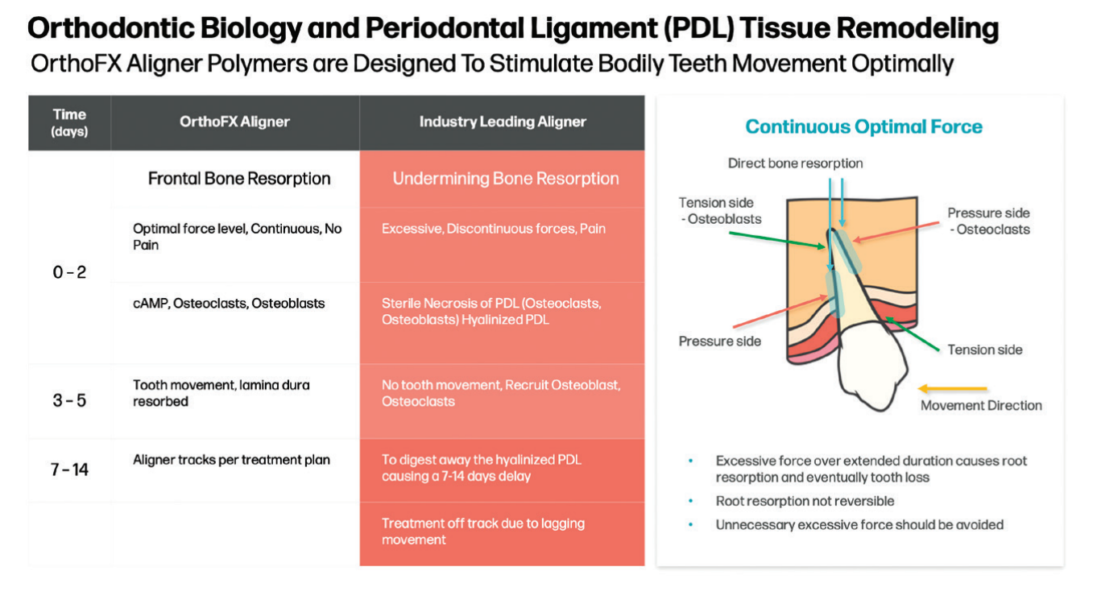
NiTime Aligners use a new, patented construction
NiTime Aligners can produce optimal forces for tooth movement thanks to their new, patented construction. In contrast, standard aligners used by major brands are made from sheets of plastic that are fused together. Regardless of the number of layers, the physical property differences between the various pieces, or the order of their integration, they are still within the thermal plastic material classification.
When thermal plastic experiences stress, it behaves as a viscoelastic material, meaning it can deform, yield, or even break when bent. Very little strain results in extreme levels of stress since thermal plastic stress and strain properties are logarithmically related. In aligner treatment, the plastic is repeatedly stressed as aligners are inserted and removed. Consequently, the performance of standard aligners declines over the course of wear, causing each stage of aligners to potentially fall short of achieving the planned movement. Any insufficient movement, known as lag, compounds each week until a refinement is required.
NiTime Aligners do not experience these limitations because they are not made from a single sheet or multiple sheets laminated into a single sheet. Instead, each aligner is composed of two shells with a cushion of air between them. As the teeth move, the NiTime aligners adapt closely to fit the teeth, and the air between the shells shifts to maintain optimal forces for tooth movement. By combining the benefits of “HyperElasticity” with improved patient compliance, lag is avoided (Figure 2).
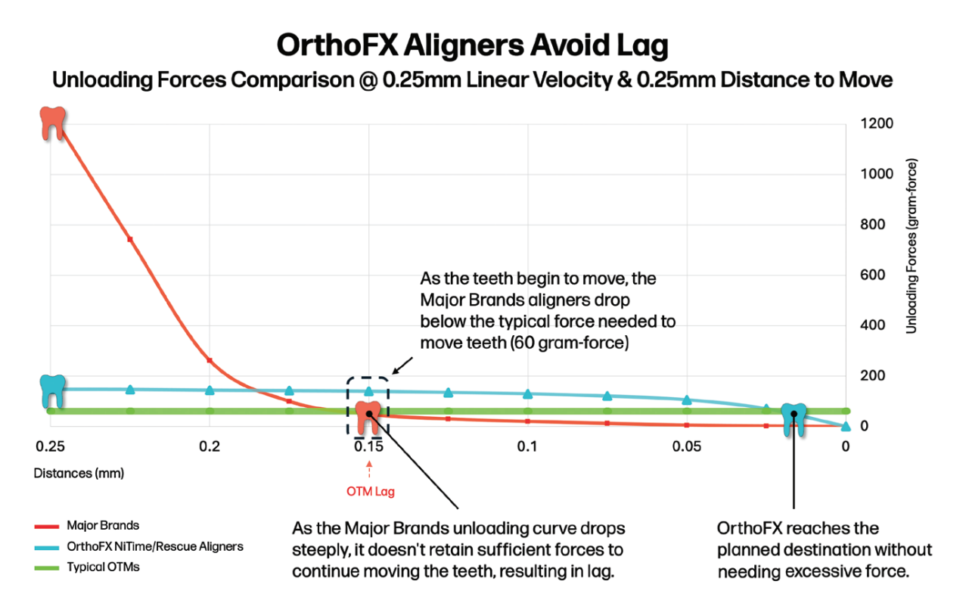
Case examples
The following patients chose NiTime Aligner therapy due to specific circumstances that limited their options. With greater comfort and a reduced wear time, these patients were able to benefit from aligner treatment despite their lifestyle, occupational, and condition-related challenges.
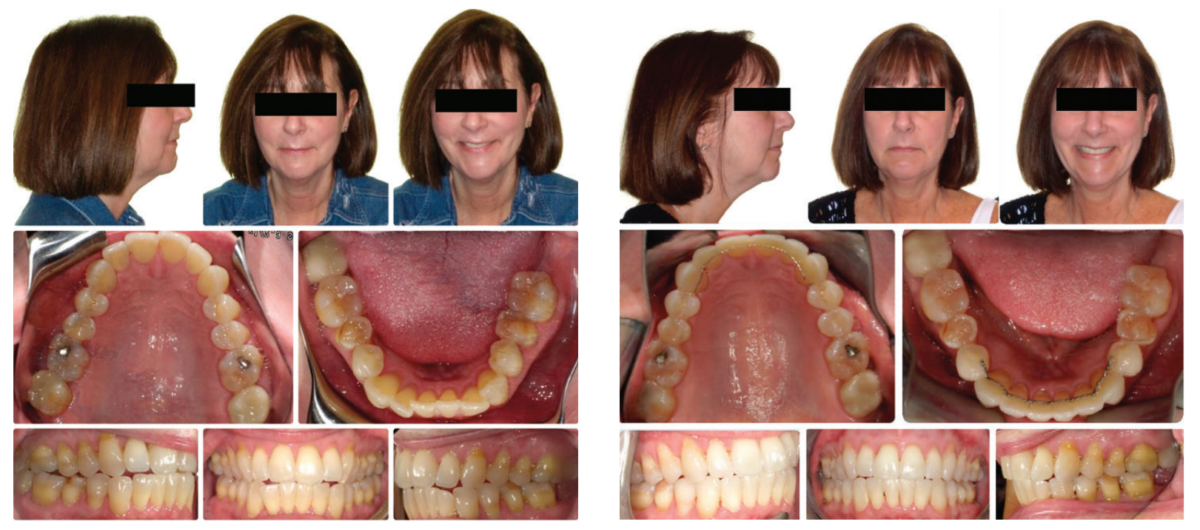
Case 1 (Figure 3)
Contributing clinician: Dr. Neil Warshawsky, Illinois
In the first case example, a 60-year-old patient, relapsed from prior orthodontic treatment, presented with an edge-to-edge bite, bilateral crossbite, and gingival recession. She had a periodontal consultation but decided to postpone surgery until after her son’s upcoming wedding. She requested a system that moves teeth more gently due to her periodontal concerns.
The doctor planned for expansion in the upper and lower arches with elastics on the first molars as well as enameloplasty for the upper-right incisor. The treatment objectives were achieved in 7 months with no worsening of her gingival recession. In addition to her periodontal status remaining stable, the patient’s primary goal of completing treatment in time for her son’s wedding was successfully met.
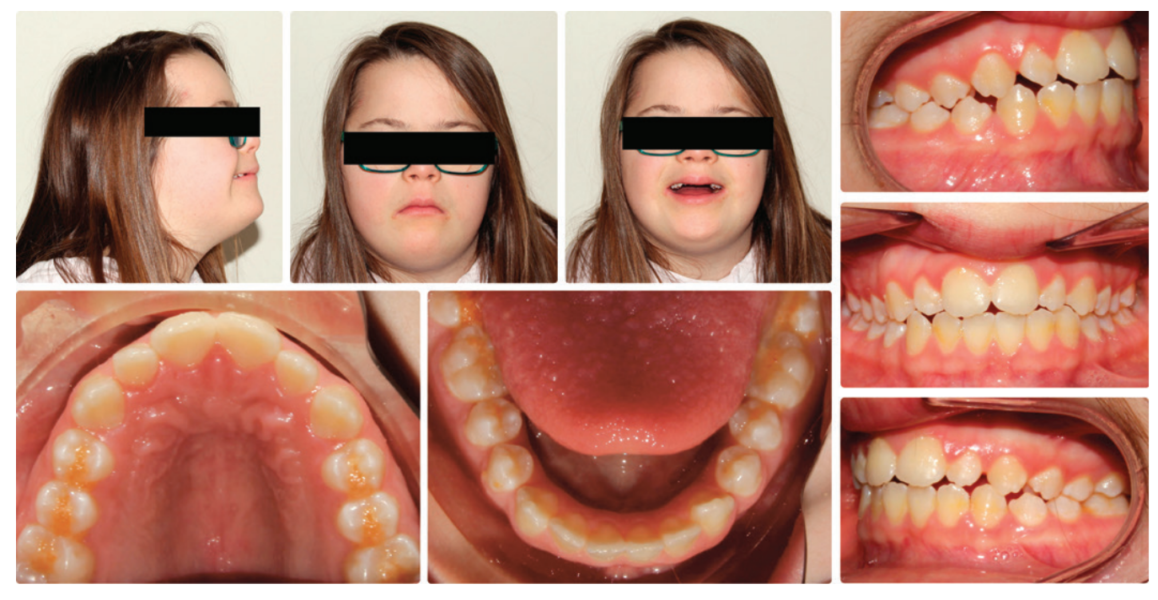
Case 2 (Figure 4)
Contributing clinician: Dr. Bill Dabney, Virginia
In this case, the patient is a 13-year-old with Down Syndrome and sleep apnea. NiTime appealed to the patient’s mother since she was very happy her daughter did not have to take her aligners to school. Mom did not want her daughter to have to keep up with her aligners and was afraid she would lose them. Mom was also very concerned about hygiene with braces.
The treatment plan is to close all spaces and extrude the incisors to close the open bite.
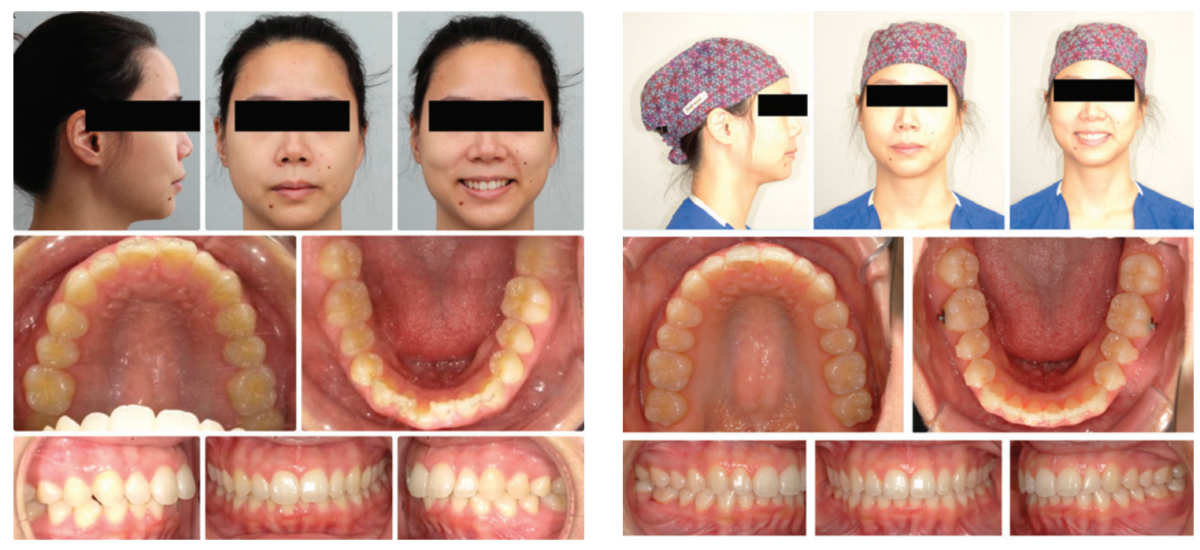
Case 3 (Figure 5)
Contributing clinician: Dr. Neil Warshawsky, Illinois
The next case example is a 33-year-old relapse patient who is a very busy plastic surgeon. She did not consider correcting her relapse until she heard about NiTime Aligners. She was 50% Class II and moderately crowded. The treatment plan was to level the lower occlusal plane and use Class II elastics for the right buccal segment to correct the tooth interdigitation as well as broaden the buccal segment and resolve crowding in the anterior teeth.

Case 4 (Figure 6)
Contributing clinician: Dr. Neil Warshawsky, Illinois
This 33-year-old patient was a Class I Div 2 malocclusion with a moderately deep overbite, moderate upper/lower crowding, and retroclined incisors. She also had gingival recession on the lower canines and first premolars. She chose NiTime since she is a teacher and felt self-conscious about undergoing orthodontic treatment.
The treatment plan was to resolve her crowding through expansion with Class II elastics to procline the maxillary incisors and increase the overjet. The plan will also intrude the incisors and extrude the premolars to assist in the leveling of the case. Her treatment progress is shown at stage 28.
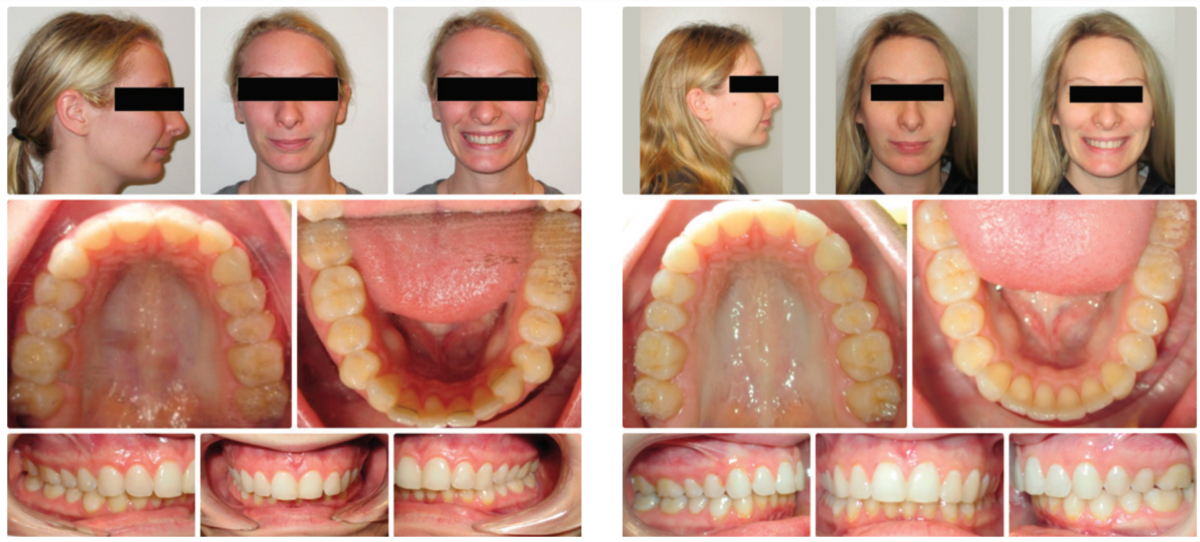
Case 5 (Figure 7)
Contributing clinician: Dr. John Conroy, Connecticut
The final case example is a 28-year-old patient who received orthodontic treatment initially at age 10, completing it at age 13 with braces, elastics, and springs, resulting in a Class 1 outcome. Lingual retainers were placed posttreatment; however they were broken during a dental cleaning years later. The patient returned with minor rotations of the lower incisors and excess overjet. The overjet was her chief complaint.
As treatment was about to begin, the patient learned she was pregnant and so refused attachments. Treatment was able to proceed due to the HyperElasticity of NiTime Aligners. Treatment results were: overjet improved, Class I maintained, and crowding corrected in 7 months (22 stages). The patient achieved a satisfactory outcome despite declining planned attachments.
Conclusion
OrthoFX NiTime Aligners stand out as the only clear aligner on the market FDA cleared for reduced wear time without any compromise to treatment duration. This milestone has enabled doctors to provide treatment to patients who might otherwise postpone or avoid treatment due to discomfort or disruption to their job or lifestyle. Marketed as a “compliance-friendly” system, NiTime offers a unique solution for patients seeking more comfortable and convenient aligner treatment.
Read more about how OrthoFX NiTime Aligners can improve compliance and predictability in this article by Dr. Neil Warshawsky and Loc X. Phan. https://orthopracticeus.com/improving-patient-compliance-and-predictability-with-hyper-elastic-aligners/
- Pilon JJ, Kuijpers-Jagtman AM, Maltha JC. Magnitude of orthodontic forces and rate of bodily tooth movement. An experimental study. Am J Orthod Dentofacial Orthop. 1996 Jul;110(1):16-23.
Stay Relevant With Orthodontic Practice US
Join our email list for CE courses and webinars, articles and mores


